
Bed bugs are on the top of the list, being the most feared infestation. These creepy crawlers like to hide under mattresses, In curtains, carpet and in wall voids. Bed bugs can lay one to twelve eggs a day and two-hundred to five hundred in one lifetime.
Bed Bug Preparation
The following steps must be completed for an effective service to be performed.
DO NOT PUT BED BUG COVERS BACK ON UNTIL LAST TREATMENT IS COMPLETE.
Schedule your free inspection with Jimenez if you believe to have bed bugs or been in contact with someone that you believe to have bed bugs.
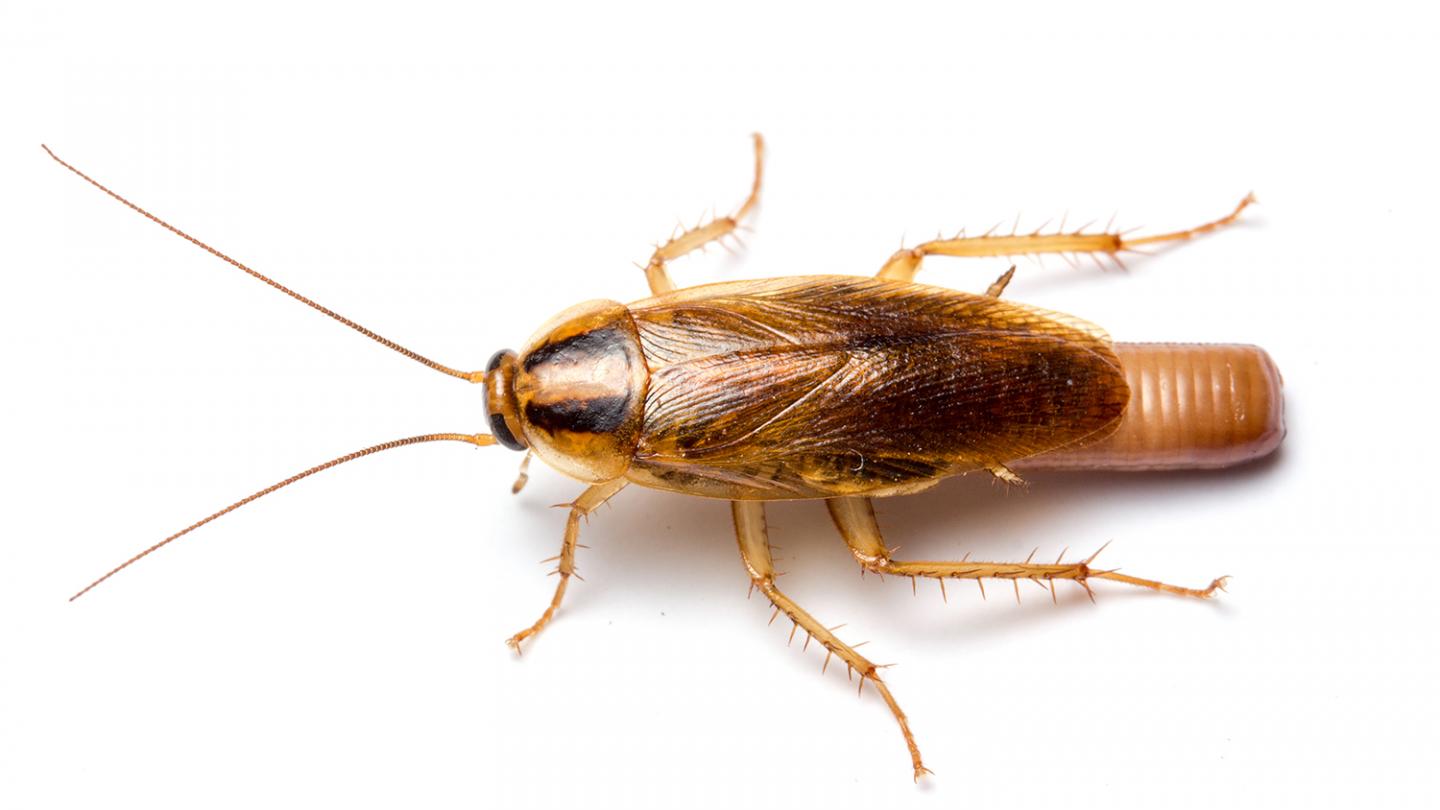
German roaches are particularly associated with residential homes, multi-family homes, restaurants, food processing facilities, hotels and nursing homes. In colder climates, they are found only near humans, since they are not very tolerant to cold. German roaches are transmitted by humans and through their belongings.
They are commonly found in the kitchen and bathroom areas of a home. From under stoves and refrigerators to hiding in the cupboards. Jimenez requires the customers to remove the stove, refrigerator from the wall and to empty out every cupboard and pantry. Also remove any item in the bathroom cabinets. German roaches require two different liquid products, a flush out product and a growth regulator (IGR). Jimenez will also add (IGR) bait around the kitchen, and glue board monitoring traps. Dusting is also recommended; we ask customers to remove all outlet casings. Your professional will dust in all cracks, crevices and wall voids. With weekly visits, it’s common to remember your professional will switch products to avoid german roaches from gaining adaptation to products. Typically, for a german roach infestation to be eliminated it takes three weekly visits and in some really bad cases four weeks.
These infestation pests do not have an inspection fee.
Size: 5/8 in.
Color: Light brown to brown with two dark brown markings on the thorax.
Body Structure: Narrow oval-shaped body with two long antennae and two dark brown longitudinal markings on the thorax.
Characteristics: Extremely fast breeders, German cockroaches can produce as many as 6 generations of offspring in a year. The female produces an egg capsule about once every 20-25 days. The capsule contains anywhere from 1 to 4-dozen eggs. After eggs hatch, the nymphs mature into adulthood in as little as 3-4 months. The total lifespan of an adult German cockroach is about 1 year. Although the species has fully-developed wings, German cockroaches are incapable of flight; however, they can glide short distances if it feels threatened.
Habitat & Behavior: Like other roaches, the German cockroach is omnivorous. They prefer warm, moist conditions, which is why they often are found in kitchens and bathrooms, hiding in crevices and cracks. Because they are proliferating reproducers and have few natural predators, German cockroach infestations can grow rapidly. German cockroaches are the most typical invaders of apartments, restaurants, grocery stores and anywhere food is prepared.
Prevention & Treatment: Along with sealing cracks and crevices where the German cockroach can enter your home, making sure food preparation areas are clean will help prevent infestation. Likewise, clearing clutter such as newspapers or piles of clothes is also suggested since German cockroaches are omnivorous scavengers who will eat anything, including paper and cloth. Because German cockroaches reproduce quickly, do-it-yourself treatments are not recommended. Roach bombs can be toxic and highly dangerous for humans and pets alike if administered incorrectly. If you believe you have a roach infestation, contact a pest control professional to identify the species and administer proper treatment. Find out more about roach extermination options.
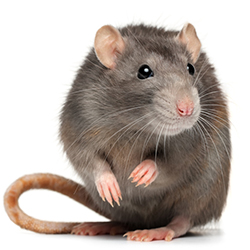
Other Names: Black Rat, Fruit Rat, Ship Rat, Alexandrian Rat
Diet
Daily Amount: 0.5-1 ounce
Daily Water: 1-2 ounce
Daily Food: Fruits, berries, meats, seeds, vegetables, eggs
Habitat
Geography: Coastal cities; as a general rule they do not occur more than 100 miles inland
Nest Location: Nests in attics, false ceilings, dead fronds of palm trees, and upper portions of buildings
Home Range: Up to 300 ft from nest
Active Periods: Nocturnal; most feeding occurs 30 minutes after sunset and before sunrise
Reproduction
Litter Size: 4-8 pups per litter
No. of Litters: 3-4 per year
Sexual Maturity: 2-3 months
Breeding Season: Indoors: All year; Outdoors: Spring & Fall
Top 10 High Activity Areas
• Attics
• False ceiling areas
• Within fruit trees
• Wall and floor voids in upper floors
• Within dead fronds of palm trees
• Among overgrown vegetation along fence rows and utility poles
• Within brick foundation wall voids
• Beneath low-lying and cavernous shrubbery
• Along utility lines connected to exterior of home
• Beneath slab walkways
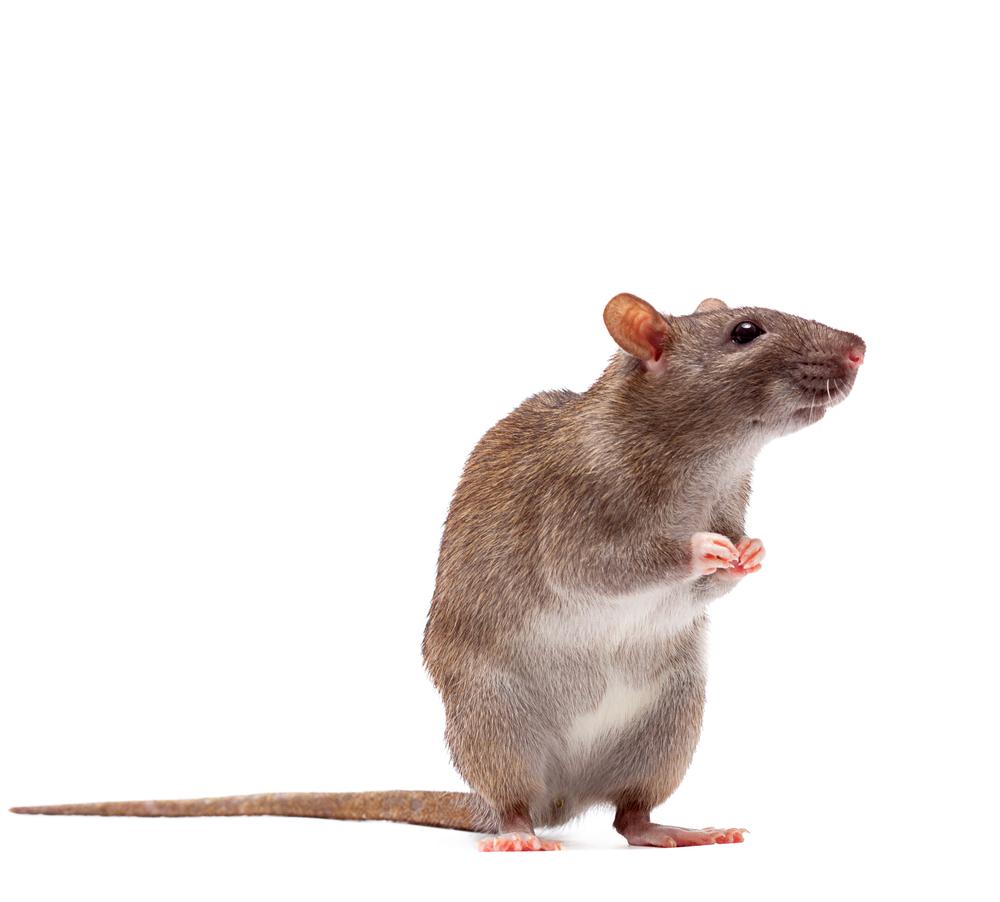
Other Names: Packrat, Traderat
Diet
Daily Amount: 0.1-2 ounce
Daily Water: 1-2 ounce
Daily Food: Seeds, vegetation, nuts, berries, twigs, insects, small mammals, birds; Woodrats nesting inside homes often continue to feed outside
Habitat
Geography: Throughout US, although absent from New England & Great Lakes states
Nest Location: Stick “houses” under porches, inside sheds, attics, soffits, hard to reach wall & ceiling voids; similar to roof rats
Home Range: ¾ of an acre
Active Periods: Nocturnal; but common to see juveniles during the daytime
Reproduction
Litter Size: 2-4 pups per litter
No. of Litters: 1-4 per year
Sexual Maturity: 2-3 months
Gestation Period: 38 days; slow population growth
Breeding Season: Outdoors: Spring

Other Names: Brown Rat, Gray Rat, Common Rat, House Rat, Wharf Rat, Water Rat, Barn Rat, Sewer Rat, Super Rat
Diet
Daily Amount: 0.5-1 ounce
Daily Water: 1-2 ounce
Daily Food: Cereal grains, meats, seeds, cockroaches, fruits, shrimp
Habitat
Geography: Throughout the US and Canada
Nest Location: Burrows in soil, sewers, basements, lower portion of buildings
Home Range: 25-100 ft from nest
Active Periods: Nocturnal; most feeding occurs 30 minutes after sunset and before sunrise
Reproduction
Litter Size: 8-12 pups per litter
No. of Litters: 4-7 per year
Sexual Maturity: 2-3 months
Breeding Season: Indoors: All year; Outdoors: Spring & Fall
Top 10 High Activity Areas
• Basements
• Beneath wood piles
• Near or beneath outside dog pens
• Garage walls near heaters and stored food
• Beneath low-lying decks
• Beneath slab walkways
• Within brick foundation wall voids
• Beneath low-lying and cavernous shrubbery
• Within 100 ft of dumpsters and garbage cans
• Beneath slabs supporting food bins
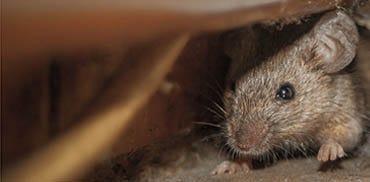
Excellent hearing, vision, smell and touch have enabled the mouse to be highly adaptable to homes and indoor buildings. All they need is a 1/4″ opening to be able to enter a building, so they often have access to many places along the building’s perimeter.
Diet
Daily Amount: 1/10 Ounce
Daily Water: Utilizes moisture in food
Daily Food: Cereal grains, meats, seeds
Habitat
Nest Location: Corners in cluttered areas, base voids of appliances; Less than 30ft from food source
Home Range: 6-30 ft from nest
Active Periods: Nocturnal; most feeding occurs 30 minutes after sunset and before sunrise
Reproduction
Litter Size: 5-7 pups per litter
No. of Litters: 6-10 per year
Sexual Maturity: 1 month
Breeding Season: Indoors: All year; Outdoors: Spring & Fall
Top 10 High Activity Areas
• Secluded corners
• Beneath cabinets
• Furniture voids – couches, chairs, dressers
• Bases of kitchen appliances – refrigerator, stove
• Ceiling and wall voids near corners and heat sources
• Top of basement and crawl space foundation walls
• Cluttered, neglected office drawers in desks
• Storage boxes in closets
• Cluttered garages
• Bases of water heaters
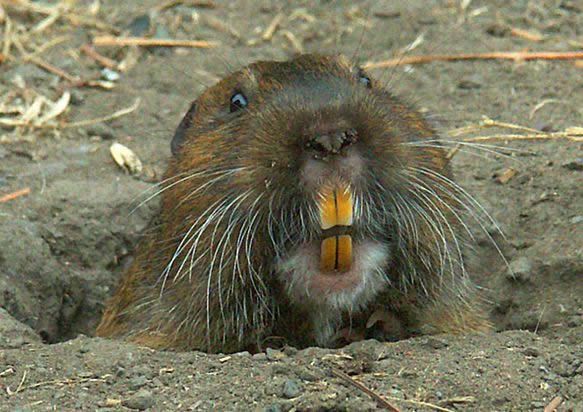
Gophers are small, burrowing animals about five to twelve inches long with an average weight of 8 ounces. Powerfully built in the forequarters, their front feet have long, sharp claws. Gophers have brownish soft fur, large cheek pouches and flattened heads with small ears and eyes. Their hairy tails are about four inches long, and are used to navigate through tunnels when moving backwards.
Gophers create fan-shaped mounds that are often large enough to cause damage to passing farm equipment. It is not uncommon for gopher tunnels to interfere with irrigation systems, dams, fields and, of course, homeowners’ lawns and gardens.
Diet: Gophers are notorious hoarders. They use their cheek pouches to store food before taking it to their burrows, where they stockpile astounding amounts of food. Gophers are omnivores and love to eat nuts, berries, grass, bulbs, leaves and insects.
Daily Amount: 60% of its body weight each day
Daily Water: Utilizes moisture in foody
Daily Food: Nuts, seeds, roots, grass, bulbs, berries, leaves, insects
Habitat: Gophers live throughout North America, in woodland and grass prairies and from coastal to mountainous regions. They spend their days building complex underground tunnel systems in areas where the soil is soft and easily tunneled.
These large networks can often contain thousands of gopher residents. Gophers are attracted to moist, light-textured soil with edible vegetation. Their main runways are located up to 18 inches below the surface of the earth.
Geography: Regional North America
Nest Location: Underground tunnel systems 18 inches below ground; nesting burrows up to 6
feet below ground
Home Range: Up to 700 yards
Active Periods: Day and Night
Reproduction: Gophers breed only once or twice a year, typically in the spring. Female gophers give birth to three or four young per litter after a gestation period of less than three weeks. The young develop rapidly and by five weeks are weaned and ready to establish their own burrows. The average lifespan for a gopher is two to three years.
Litter Size: 3-4
No. of Litters: 1-2 per year
Sexual Maturity: 6-12 months
Breeding Season: Spring
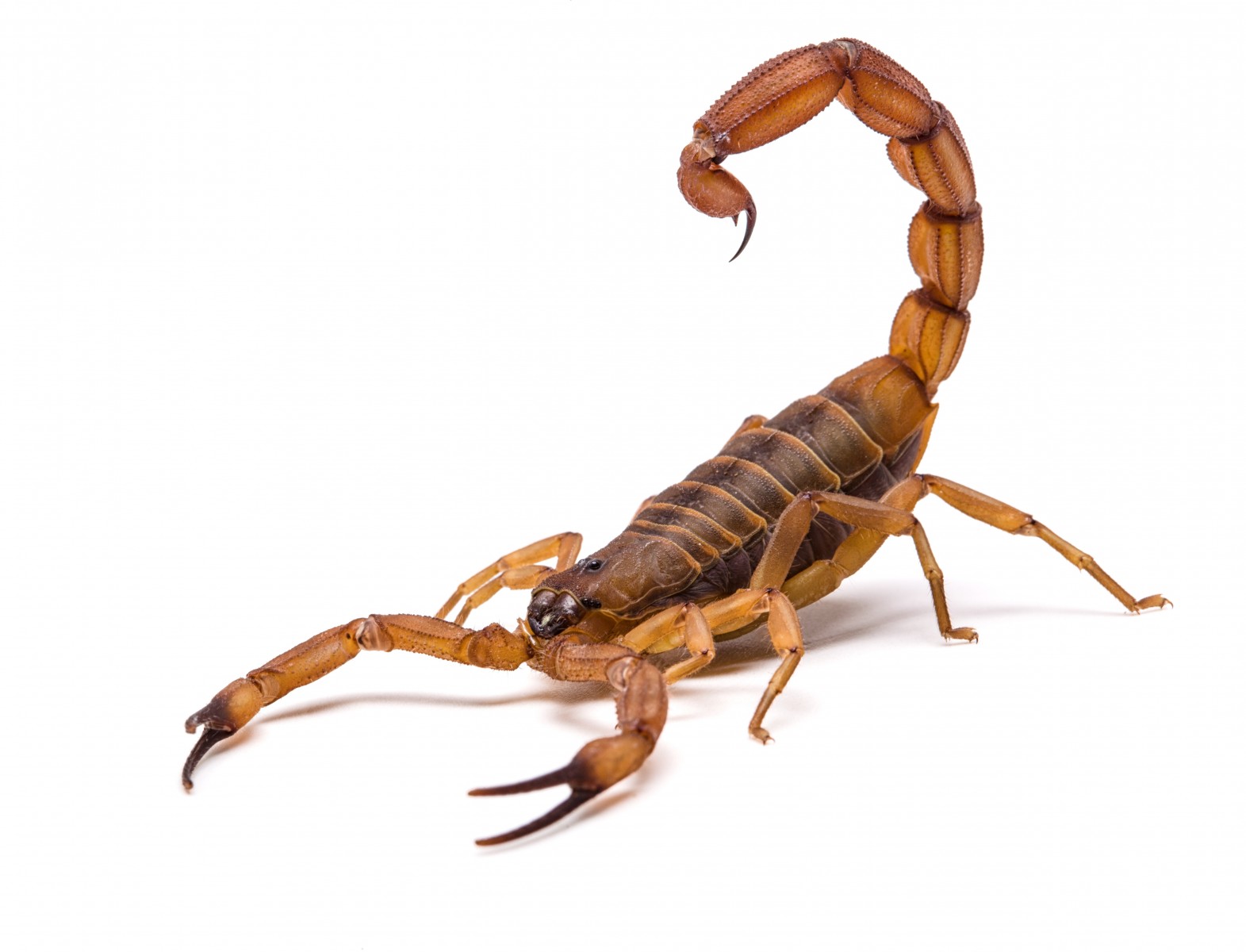
Your personal professional is trained to help manage Arizona bark scorpions and similar pests. Since every building or home is different, a personal professional will design a program for your situation. Jimenez can provide the right solution to keep your home, or business Arizona bark scorpion free.
Size: This scorpion species grows up to 7 cm, or 3″ long
Color: Light brown to brownish yellow in color, with dark lengthwise bands
Characteristics: Their pincers are elongated and thin, unlike other scorpions that have thick, lobster-like pedipalps. Their tail is also slender and yellow to light brown in color.
Habitat & Behavior: The feeding habits are similar to that of other scorpions. The Arizona bark scorpion prefers to hide and will cling to almost anything. It is nocturnal and feeds on crickets and other insects that happen to pass by its burrow. These scorpions prefer to dwell in areas that can support insects, and other small prey species. These areas must also have sufficient amounts of moisture and humidity. All scorpion species are venomous, with their stings varying in severity and discomfort. The pain of a scorpion sting is similar to that of a bee, and the symptoms are mild. However, there are a handful of scorpion species that deliver fatal stings to humans, like the Arizona bark scorpion in the US.
Geographic Range: The Arizona bark scorpion can be found in the Southwestern U.S. It is especially widespread in most parts of Arizona. Small populations of this scorpion have been observed in southeastern California and southern Utah. They can also be found throughout the Baja Peninsula and western Mexico.

The brown-banded cockroach is commonly found in homes and apartments, but is less common in restaurants. You may need a cockroach extermination service to drive the brown-banded cockroach out of your home. They tend not to be found in the daytime since they avoid light. The brown-banded cockroach eats a wide variety of items, almost anything organic, including decaying matter.
Size: ½ in.
Color: Males are brown and females are brown-black; both sexes have a light-colored band running across their wings. Body Structure: Narrow, oval-shaped body with antennae and banded wings.
Characteristics: Females carry an egg capsule, holding up to 18 eggs, for 2-3 days and then deposit the capsule under a protective surface near food. Eggs can hatch anywhere from 30-100 days after being laid. Nymphs take anywhere from 3 to 9 months to develop into adults. The typical lifespan of a brown-banded cockroach is approximately 1 year. Also, unlike some other species, brown-banded roaches are capable of flight.
Habitat & Behavior: Brown-banded roaches are omnivorous scavengers and will eat anything from plant to animal material. They are largely nocturnal and prefer warm, dry locations as opposed to moist habitats. Brown-banded roaches often are found lurking around furniture, in cabinets or in closets. In fact, furnishings are a favorite place for females to deposit egg capsules.
Prevention & Treatment: Sealing cracks and crevices where roaches can enter your home is a good first step to preventing infestation. Seeing a single brown-banded cockroach may indicate that there is a larger infestation in your home.

Oriental cockroaches are sometimes referred to as “black beetles” because of their dark black appearance. Oriental cockroaches are slow movers, can barely climb and few are capable of flying. They will eat practically anything they can find, from the finest food to the disgusting slime that builds up in drains. The oriental cockroach is one of the filthiest of cockroaches but can be eliminated by our professional pest control services.
Size: 1 in.
Color: Dark brown
Body Structure: Oval-shaped body. Females have a slightly broader body and functionless wing pads. Males have fully-developed wings yet are incapable of flight as well.
Characteristics: The adult female will lay an egg capsule, which she carries attached to her abdomen for about a day before depositing the capsule near a food source. Females produce around 8 capsules, each containing 16 eggs. The gestation period is approximately 2 months. When eggs hatch, the offspring emerge as nymphs. Depending upon environmental conditions, it can take anywhere from 6 months to 2 years for nymphs to develop into mature adults, molting anywhere from 7-10 times during the process.
Habitat & Behavior: The Oriental cockroach prefers moist, dark areas and is found under porches, in crawl spaces, and around sewer drains and pipes. Likewise, they can be found in and around decaying plant and animal life, indoors or out. Oriental cockroaches are known disease carriers and can spread a number of microorganisms known to cause gastrointestinal distress.
Prevention & Treatment: Sanitation, especially in food preparation areas, is important. Likewise, sealing cracks around your foundation and caulking gaps around pipes, doors, windows and under cabinets will help keep Oriental roaches out.
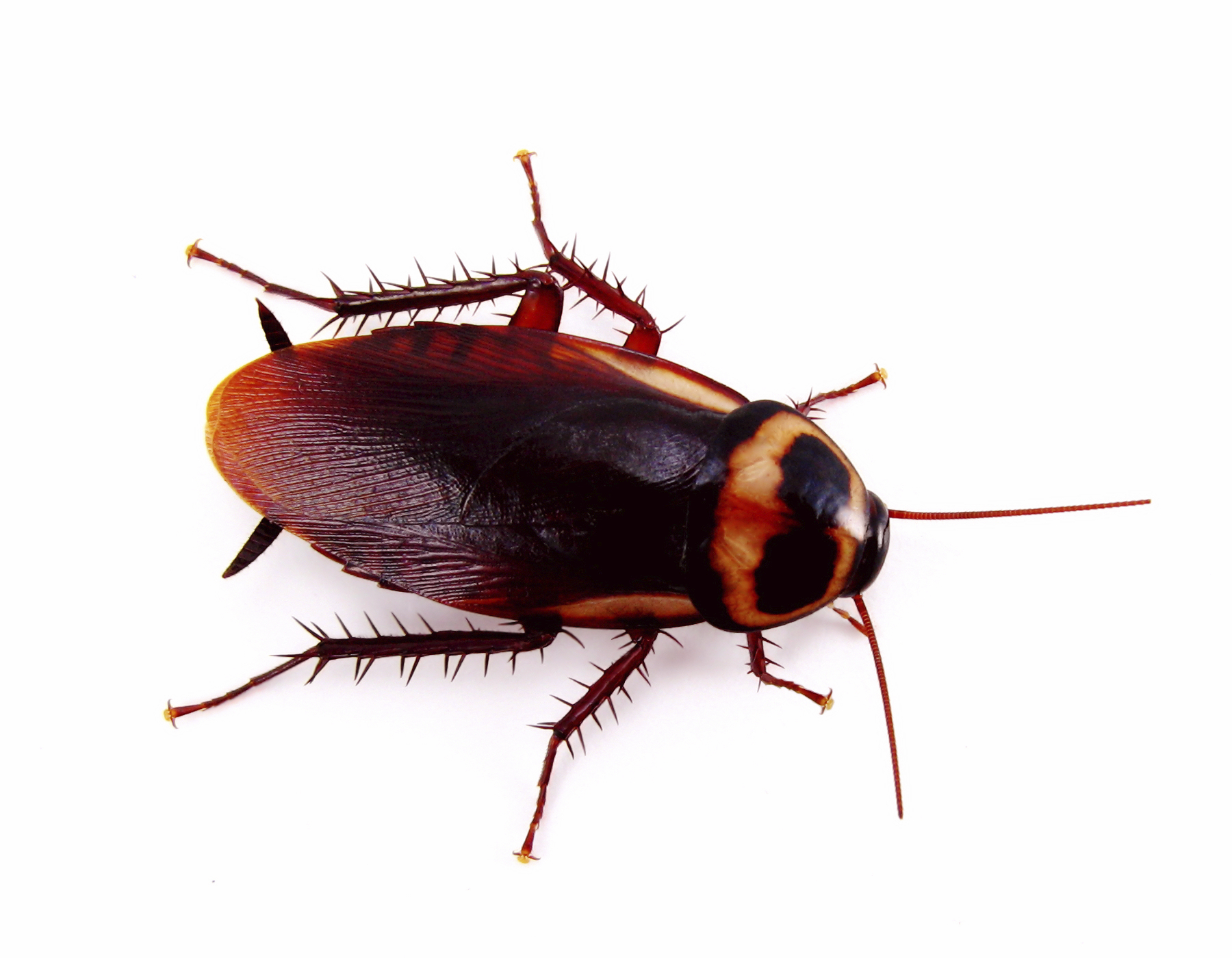
The American cockroach, also known as the waterbug, is the largest species of common cockroach. They are generally an outdoor species, living in wood piles, decaying trees, palm trees and in sewer systems.
American Cockroaches eat almost anything, including meats and grease, starchy foods, sweets, baked goods, leather, wallpaper paste, bookbindings, and sizing. No one wants cockroaches invading their home, learn more about how you can get rid of these pests with pest control service.
Size: Up to 2 in.
Color: Reddish brown
Body Structure: Oblong-oval body with antennae and yellow band behind the head
Characteristics: Females lay an egg case, containing anywhere from a dozen to 16 eggs, and then carry the egg case on their abdomens before depositing it near a food source. Eggs hatch after around 60 days, although it takes one year for the nymphs to reach adulthood. Females may lay anywhere from 15 to 90 egg cases in a lifetime.
Habitat & Behavior: American cockroaches are often found damp, dank areas–basements, near water pipes, boiler rooms, etc. One may also find them inhabiting landscaping around a residence. Although they primarily stay outdoors, they may invade a home if the climate changes or food runs low. Inside homes, they may be found lurking in food preparation areas. Unlike some other species, the American cockroach is capable of flight. In addition, whereas other roaches tend to hide in nooks and crannies, American cockroaches tend to congregate out in the open.
Prevention & Treatment: Sealing cracks and crevices around doors and pipes is a good prevention tool. American cockroaches also tend to enjoy sweet foods, so keeping food preparation areas clean is key to preventing infestation, too. Even though you’re more apt to see an American cockroach during daylight hours than other roach species, they are evasive. So, seeing one cockroach may be indicative of a much larger problem. Although there are a number of do-it-yourself treatments out there, such as roach foggers, they can be ineffective if administered improperly. What’s more, they can be highly toxic to pets and humans.
The German cockroach is very successful at establishing an ecological niche in buildings, and is resilient in the face of many pest-control measures. Reasons include:
• lack of natural predators in a human habitat
• prolific reproduction
• short reproductive cycle
• the ability to hide in very small refuges
• sexual maturity attained within several weeks, and
• adaptation and resistance to some chemical pesticides.
1. Remove indoor trash or keep them emptied.
2. Keep trash dumpsters clean.
3. Make sure food is not left in sink strainers and frequently run the garbage disposal.
4. Seal food containers.
5. Keep dishes clean, no residue of food remaining.
6. All kitchen appliances (microwaves, toasters, ovens, refrigerators, and stoves) should be maintained in a clean condition so that it is free of food and grease.
7. Pick up all the pet food.
8. Do not leave food out in the open.
9. Sweep or vacuum food particles or crumbs.
10. Get rid of empty soft drink bottles, paper bags, and cardboard boxes.
-German roaches egg cases around kitchen counters or cabinets.
-Their droppings look like black pepper and would also be found near wood in cracks and crevice areas in kitchen or bathrooms.
-When turning on lights in your home, especially in the kitchen or bathroom you notice german roaches scattering.
-Other great areas to inspect would be;
• Cracks and Crevices
• Behind and under refrigerators
• Behind and under stoves
• Behind and under microwaves and toasters
• Under tops of tables
• Behind and under sinks
• Cabinets-corners and cracks and crevices
• Motors of refrigerators and soft drink dispensing machines
• Switch Boxes and electrical outlets
• Under and behind cafeteria counters and soda fountains
• Cash registers
• Telephones
• Vegetable bins
• Recycling bins
• Meat counters and check-out stands
• Meat cutting blocks
• Anywhere else conditions are favorable.
• Every situation may be different, inspect all places with favorable conditions.
Color:
– Light Brown to Brownish
– Yellowish
Body Features
– Long Slender Metasomas (the tail that holds the stinger)
– Two Thin Pinchers
– Eight Legs
– Typically 2.5 inches in length
Color:
– Light Brown to Brownish
– Yellowish
Body Features
– Long Slender Metasomas (the tail that holds the stinger)
– Two Thin Pinchers
– Eight Legs
– Typically 2.5 inches in length
Color:
– Light Brown to Brownish
– Yellowish
Body Features
– Long Slender Metasomas (the tail that holds the stinger)
– Two Thin Pinchers
– Eight Legs
– Typically 2.5 inches in length
